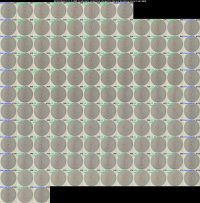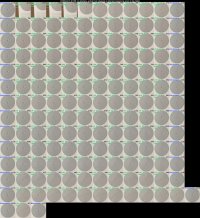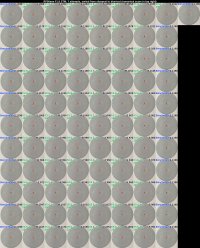See my other posts for details of the goals and methodology. But in short, these targets are 1:1 selections from laser printer-printed targets under household incandescent, hand-held in a seated position. The selections are sorted, for each shutter speed, from sharpest to least sharp. A benchmark example starts and ends each row for ease of comparison. The scores are for guidance only; please let your eyes be the judge. Finally, this target is 55lp/mm and the lines are only 2 pixels thick on an R5. If you are reducing 4:1 or more (e.g., width is 2048 or fewer pixels, even the sharpest possible image would become a grey circle, so even the worst of these images or probably still very usable.
 www.canonrumors.com
www.canonrumors.com
 www.canonrumors.com
www.canonrumors.com
CONCLUSIONS:
1. Stopping down both of these lenses seems to bring a lot more sharpness than long shutter speeds cost. The best images in the series were the point I stopped the 50/1.8 down to f/2.5, even though the shutter speed was 1/4 sec! Even the worst of ten shots at 1/4 was excellent. For the zoom, there was a marked up-tick when I stopped down to f/5, even though it came when I was also going from 1/2 sec to 1 sec.
2. For the 50mm, the worst shot from 1/2 to 1/30 sec was sharper than the sharpest shot at any speed above 1/30! So even if you have a huge amount of light, try not to shoot this lens faster than 1/30, unless you need to stop action or have too much light. Go down to 1/2 sec with full confidence.
3. The 24-105 has unreliable IS until you get at 1/30 or better. Then it's reliable. But here, 1/30 to 1/60 is your sweet spot, unless you need to stop action or simply have too much light.
4. If you can shoot 1/30 or faster, there's no reason to swap lenses. But slower than that, the 50/1.8 does a more RELIABLE job than the zoom. This is counterintuitive as the 24-105 has in-lens IS while the 50/1.8 doesn't. Further, you can (should!) stop the 50/1.8 down at which point it becomes sharper yet.
135mm SHOOTOUT! Detailed Analysis of the Hand-Holdability and General Sharpness of the RF135/1.8, the RF100-500/4.5-7.1, and the EF135/2
Reikan Focal looks interesting... I'll bookmark it. What's AFMA? From my 90s lens collection, sharpest aperture always seemed to be two stops down. But now, the 135/1.8 and 100-500 (at least at 100-135) are so sharp wide-open that I think a 45MP sensor can't even make use of any more...
100mm SHOOTOUT! Detailed Analysis of the Hand-Holdability and General Sharpness of the RF100/2.8 Macro, the RF100-500/4.5-7.1 and the RF24-105/4
See my 135mm shootout thread for details on the methodology, but I'll summarize here: These are 55 lp/mm charts, which make the black lines about 2 pixels wide on an R5. This target has detail that is totally invisible unless your final image is reduced less than 4:1, and really only if...
CONCLUSIONS:
1. Stopping down both of these lenses seems to bring a lot more sharpness than long shutter speeds cost. The best images in the series were the point I stopped the 50/1.8 down to f/2.5, even though the shutter speed was 1/4 sec! Even the worst of ten shots at 1/4 was excellent. For the zoom, there was a marked up-tick when I stopped down to f/5, even though it came when I was also going from 1/2 sec to 1 sec.
2. For the 50mm, the worst shot from 1/2 to 1/30 sec was sharper than the sharpest shot at any speed above 1/30! So even if you have a huge amount of light, try not to shoot this lens faster than 1/30, unless you need to stop action or have too much light. Go down to 1/2 sec with full confidence.
3. The 24-105 has unreliable IS until you get at 1/30 or better. Then it's reliable. But here, 1/30 to 1/60 is your sweet spot, unless you need to stop action or simply have too much light.
4. If you can shoot 1/30 or faster, there's no reason to swap lenses. But slower than that, the 50/1.8 does a more RELIABLE job than the zoom. This is counterintuitive as the 24-105 has in-lens IS while the 50/1.8 doesn't. Further, you can (should!) stop the 50/1.8 down at which point it becomes sharper yet.



